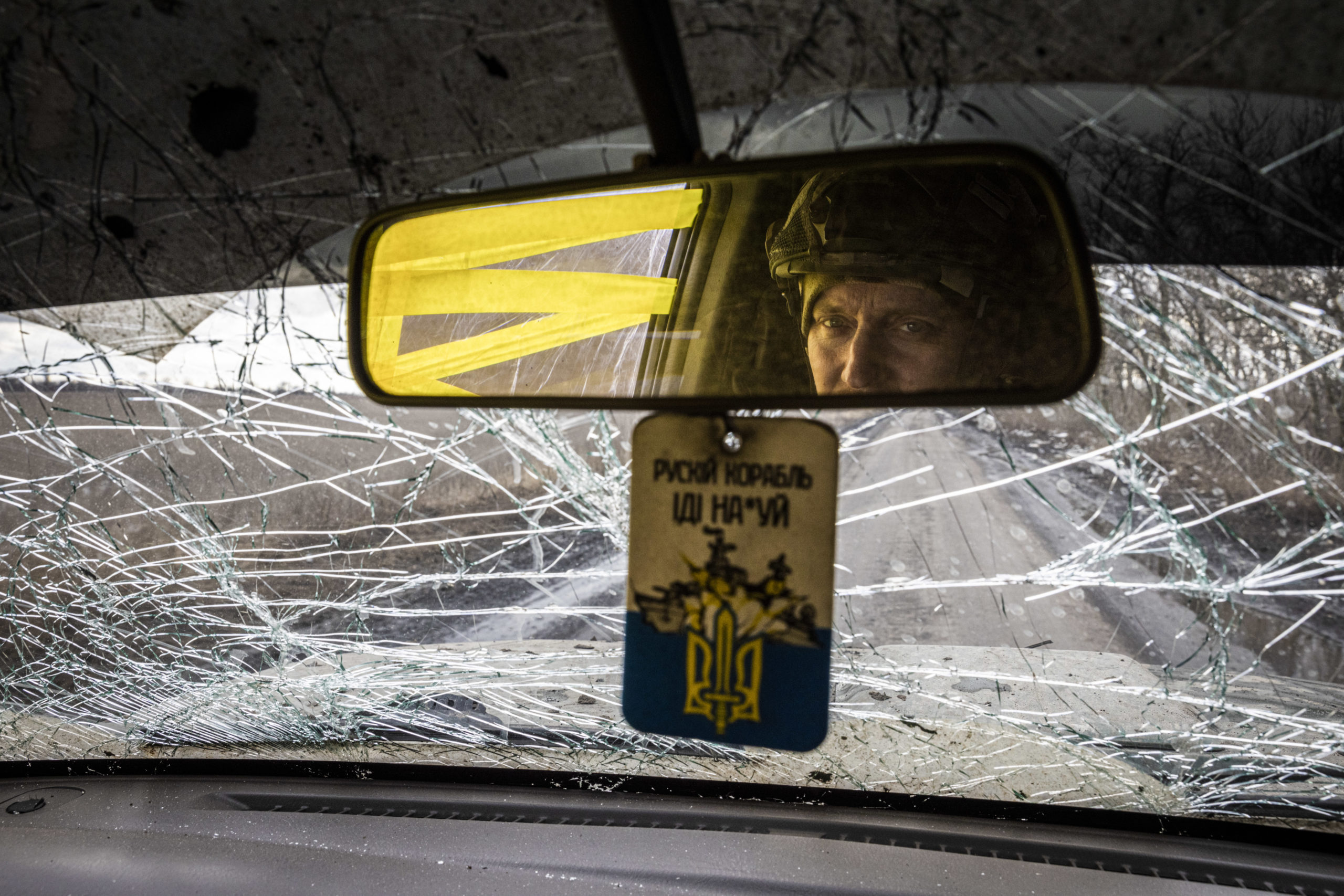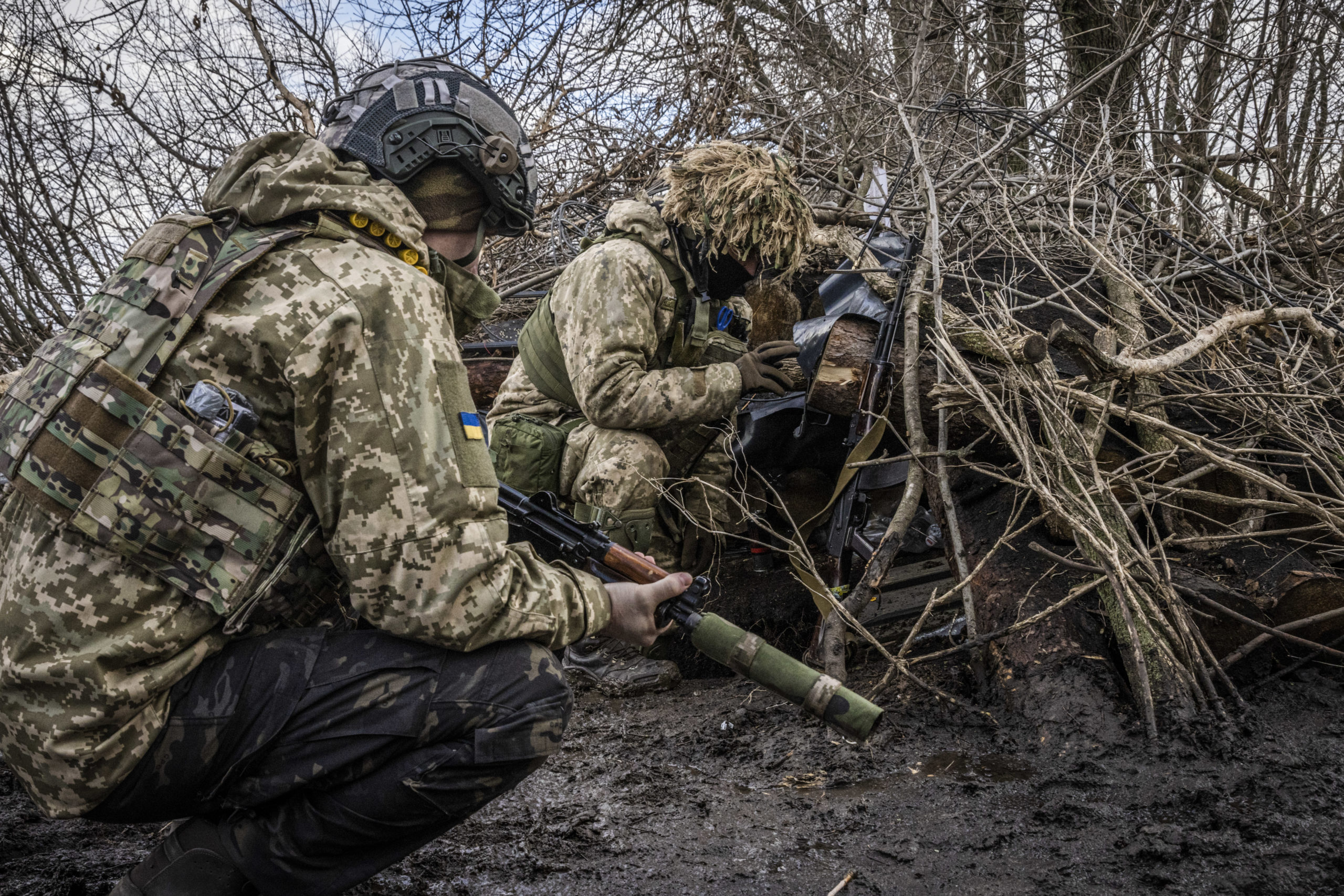The car struggles up the road, drifting through a sea of thick black mud towards a Ukrainian drone base a mile from the frontline. The Nissan Patrol has seen better days: half its windows were shattered by a shell strike the day before, and its doors are puckered with shrapnel marks. “Don’t worry,” Dymtro, the local commander in the driving seat, said as we set off, pointing at the fragments of glass scattered across his ride. “They will not go in your ass.”
Suddenly, there’s an explosion to the left. A patch of boggy woodland a few metres away erupts with a soft thump. A standard 82mm Soviet high explosive mortar round can kill from 30 metres away, but, somehow, the tiny bits of jagged metal fly past us.
Such near misses are a feature of daily life for the Ukrainian men and women holding the line against the better-equipped and more numerous Russian forces. But around the town of Vuhledar, in southern Donetsk, there is a more urgent threat: the never-ending waves of failed tank and infantry assaults. As the world’s attention has been focused on the “meat grinder” fortress city of Bakhmut 100 miles to the northeast, another giant offensive is playing out here. Six weeks after Russia launched its largest assault on Vuhledar, this once relatively prosperous coal-mining town of 15,000 people — the name translates roughly as “the gift of coal” — is now a wasteland.
The reason for Russia’s relentless stream of attacks in Vuhledar is straightforward. For Ukrainian forces, the area around the town is a strategic gem, allowing its drone and artillery teams to target Russian supply lines. For Russia’s army, it is equally important. If it can take control of the town and surrounding area, it will gain access to key tarmac roads and railways that lead both north to Bakhmut and east towards Crimea. Seizing it would effectively cut Ukraine’s southern flank wide open.
One of the key units charged with preventing this is the 68th Jaegers, an anti-tank brigade formed at the start of the war. Armed with Browning 50-calibre machine guns, handheld drones and old Soviet anti-tank guns, they have spent the past month guarding cratered farms and bleak woodlands against the Russian advances. The closest section of the front line is just 70 metres away from enemy positions; the constant thud of artillery duels echoes across the plains and ruined hamlets. The Russians lob artillery over every 40 seconds, and the Ukrainians try to send something back. “It’s like badminton,” explains Dymtro.
In the past three weeks, Dymtro’s unit has repelled more than half a dozen offensives as the Kremlin seeks to gain the initiative after months of wintery stalemate. The ensuing battle has turned into the largest tank engagement since the war started. “The Russian offensive tactics are always the same,” he says. “First, they fire artillery. Then tanks and BMPs [armoured infantry fighting vehicles] go in. Next are the infantrymen. But we fire back at them and they usually run away. When we hit their BMPs, they run away immediately.” Dymtro describes one recent Russian attack, when the 68th Jaegers fought off 12 tanks and four armed vehicles. “We destroyed two tanks and two armoured vehicles. We killed a lot of infantry.” “We have not given them any ground,” adds his commander.
Certainly, Russian progress in Vuhledar can be measured in metres, rather than miles. But the Kremlin knows this battle can be won with persistence. “They send them, wave after wave, group after group, towards Ukrainian positions,” explains Yigal Levin, a former Israeli military officer now training Ukrainian troops. “Of course, they are getting killed. But they send more and more until Ukrainians run out of ammunition. This is why it’s so important that ammunition is supplied from the West. We often see that in the Wagner Group’s advances in the East. They are making advances in Bakhmut because Ukrainian units are simply broken. They ran out of ammunition, or they simply couldn’t resist the pressure of these ‘human waves’ anymore.”

Yet around Vuhledar, the Russian soldiers are not the released convict riffraff favoured by the Wagner Group. Here, Ukrainian troops are facing elite Russian units — the 155th Marine Brigade and the 40th Motorised Brigade. “They are well-trained,” Dymtro explains. “When the marines see one of our drones with a grenade, they don’t run. They just wait for the grenade to fall down. After that, they just step aside behind a tree, wait for the explosion, step back and keep fighting.”
Perhaps this is to be expected from the 155th, a brigade which has played host to some of Russia’s finest troops since the 18th century. But the reality is less black and white: despite their reputation, the 155th has become one of the outstanding wartime symbols of Moscow’s incompetence. Over the last few weeks, dozens of videos from military drones have emerged showing Russian tanks and infantry fighting vehicles driving across open plains around Vuhledar. In almost farcical succession, they inevitably hit mines and go up in smoke, turning the fields into graveyards of scrap metal. Ukraine’s military claims that the Kremlin has lost at least 130 armoured personnel carriers and tanks in the battle for the town. In recent weeks, officials estimate that the 155th lost roughly 5,000 troops trying to capture Vuhledar; last month, up to 300 marines in the brigade were killed every day. None of these figures have been independently verified, but it is clear the Ukrainian defensive manoeuvres have been devastating: only yesterday, it was reported that senior Russian officers in Vuhledar staged a mutiny after being told to continue their attacks.
One reason for their senseless failure, Levin explains, stems from a key difference between the Ukrainian and Russian leadership. “We can see that the higher commanders in Ukraine’s army are often young people,” he says. “If we look at the war commanders in Russia and Ukraine, in Ukraine they are all 10-20 years younger, which means that they don’t have a Soviet way of thinking. They were raised during the Nineties, so they have a new approach to all this. Ukraine is also a democratic country; subordinate soldiers have less fear of their command, which leads to more flexible actions and admittance of mistakes without being afraid of fierce repercussions.” Ukrainian military leaders, he implies, would never rely on interminable waves of cannon fodder like the Russians in Vuhledar.

After several minutes of driving, the commander stops next to what looks like a fallen tree. When he starts calling softly, a thickset Ukrainian soldier tentatively emerges from a dugout covered in leaves, Kalashnikov in hand. His call sign is “Taxi-man”, an allusion to his job before the mass invasion started a year ago. Today, his job is to hold the line, sitting there for hours with only a few blankets and a pack of cigarettes for comfort, just in case any Russian troops try to slip past. “Sometimes it’s quiet. Sometimes it’s hot. This morning, the Russians fired at us with grad rockets,” he says casually.
Before he can continue, a shell whistles above and crashes down several hundred metres away. Across the field, burning hot white phosphorus starts to shower down around the area where the car had just been a few minutes before. The Russians are either trying to mark their artillery for future bombardments or think someone might be hiding there in the cold bushes. Either way, it’s time to go. “Slava,” Taxi-man says in a parting goodbye as he descends back into his hole.
A mile or so down the road, Russian armoured personnel carriers and infantry are rushing Ukrainian positions, jumping into fortified trenches. Two Ukrainian soldiers have been hit in the neck. “Evacuation impossible,” the radio crackles. Another Russian offensive has been launched — and in Vuhledar, it won’t be the last.
Disclaimer
Some of the posts we share are controversial and we do not necessarily agree with them in the whole extend. Sometimes we agree with the content or part of it but we do not agree with the narration or language. Nevertheless we find them somehow interesting, valuable and/or informative or we share them, because we strongly believe in freedom of speech, free press and journalism. We strongly encourage you to have a critical approach to all the content, do your own research and analysis to build your own opinion.
We would be glad to have your feedback.
Source: UnHerd Read the original article here: https://unherd.com/

